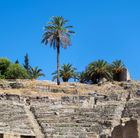Early Yponic (Pacifica)

| History of Rhayna (Pacifica) |
|---|
 |
|
|
The Early Yponic refers to the period of time between 3300 BCE and 2400 BCE, pertaining to the protohistory of Moellia, which started with the introduction of bronze metallurgy and the creation of the first simple aegean alphabets, which would later on transform into its modern variant. The Early Yponic ends with the formation of the first city-states and, more importantly, first complex military structures.
This period is also the last shared archaeological period between the three regions of Moellia. After 2400 BCE, the evolution of independent political history became the norm, and interactions between Rhayna, Alla-gy and Nea-gy became distant and limited until the invention of the steam locomotive.
Technological developments
The Early Yponic period marked significant technological advancements in Moellia, most notably the introduction of bronze metallurgy and the development of writing systems. These developments laid the foundation for more complex societal organization and the eventual rise of city-states in the region.
Bronze metallurgy
The methods of bronze metallurgy in the Early Yponic period rapidly spread through Moellia, transforming the importing economy of the region to a more local production of the alloy. Initially reliant on imported bronze from Eastern Cordilia, Moellian craftsmen eventually adopted advanced alloying techniques, combining local copper with tin from small, scarce and often disputed Moellian deposits to produce bronze artefacts. Bronze tools improved agricultural efficiency, while bronze weapons such as axes and spears provided an advantage in hunting and combat over settlements that did not use bronze. Artisans also began creating ornamental bronze items, demonstrating the material's growing cultural and economic importance.
Writing
The Early Yponic period was also marked by the development of writing in the region, with the creation of the first simple aegean alphabets. These proto-writing systems, of unknown influence, began as a means of recording trade, agricultural and agrarian surpluses, and dates. The first alphabet, Picto I, is found in use in the Tipo Valley complex, and spread along trade routes and agricultural settlements, later on diverging into Picto II in the west. It's worth emphasizing that Picto I was short-lived, disappearing after the collapse of the Bronze Age, while Picto II would evolve into [TBD].
Later on, the adoption of writing enabled a larger administrative power, more complex societal systems, the development of some of the first written laws of the Ancient South Pacific, and eventually the consolidation of the first city-states.
Settlements
During the Early Yponic period, Moellia suffered a shift from small, rural and familial communities to larger and more complex settlements. Settlements began to feature larger, more organized structures, often with central and wide roads of concentrated activity, and while most settlements remained agrarian, the growing importance of bronze production spurred the establishment of specialized workshops and production centres.
In the background, the Early Yponic period saw the beginnings of urbanization, with the first signs of proto-cities emerging. Some settlements began to adopt defensive structures, such as simple fortifications, in response to increasing competition for resources, specially with the slow development of military structures and the dispute for the few tin deposits in the region. Trade routes expanded, linking settlements across Moellia and beyond, enabling the exchange of not only goods but also cultural and technological innovations inside and out of the region. This period marked a crucial transition as the population density and complexity of settlements increased, setting the stage for the later formation of city-states. Whoever, contact between large settlements was still incredibly limited, just sharing goods through the economic routes.
Military
The Early Yponic period saw the emergence of rudimentary military structures, primarily driven by the competition for resources and the need for protection against potential external threats in Nea-gy and Alla-gy. While large, organized armies were still non-existent, individual settlements began to invest in fortifications such as simple earthworks and palisades around the largest, Bronze Age settlements. Bronze weaponry, including axes, spears, and daggers, provided a significant advantage in defence and combat, as these weapons were far more durable and easily malleable than the stone tools that had been previously used. These early military efforts were often organized on a local level, with communities relying on their own defence alone.
The increasing importance of resource control, particularly of tin deposits, led to the first signs of military organization. While standing armies did not yet exist, rudimentary military hierarchies with chieftains as heads of the defence and attack were developed, as suggested by archaeological remains.
Transition
The transition from the Early Yponic to the three distinct regional chronologies (Niclacian, Pavlavian and Moric) marked a pivotal turn in Moellia’s history, as the shared archaeological and cultural characteristics of Rhayna, Alla-gy, and Nea-gy began to differentiate. The advancements in bronze metallurgy and writing provided the foundation for the rise of independent city-states, each following unique paths in each region. This fragmentation was fuelled by regional resource disputes, and the growth of localized political and military hierarchies. By 2400 BCE, interregional interactions had become sporadic, with trade and cultural exchanges continuing in limited capacity through established economic routes over Prostasia and Defteros, and in 2375 BCE, Ennos (nowadays the city of Enois) was founded in Nea-gy during the Early Moric.